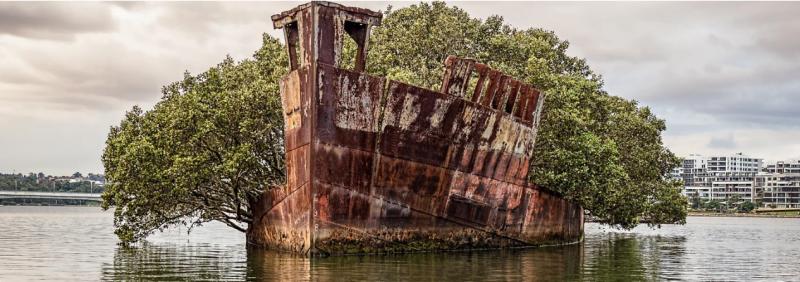 The steam collier SS Ayrfield was 61 years old. Formally called the Corrimal, the 1,140-tonne ship, ran coal between Newcastle and Sydney before serving as a transport ship for Australia during World War II. After the war, she operated again as a collier between Newcastle and Miller’s terminal in Blackwattle Bay. By 1972, she had reached the end of her useful life and was sent to a scrapyard in Homebush Bay, near Sydney, Australia, to be broken up.
The steam collier SS Ayrfield was 61 years old. Formally called the Corrimal, the 1,140-tonne ship, ran coal between Newcastle and Sydney before serving as a transport ship for Australia during World War II. After the war, she operated again as a collier between Newcastle and Miller’s terminal in Blackwattle Bay. By 1972, she had reached the end of her useful life and was sent to a scrapyard in Homebush Bay, near Sydney, Australia, to be broken up.
The ship arrived just as the scrap market collapsed and the yard closed. Part of her hull was cut away but her scrapping was interrupted. She settled into the mudflats of the bay, to rust slowly away, a tired relic of another time.
Then something remarkable happened. Mangrove trees took residence in her hull. Before long a veritable forest sprouted from the rusting wreckage. Locals called the ship affectionately, the “Floating Forest”, although the adjective “floating” is more fanciful than literal.
The old industry in Homebush Bay is gone, replaced by high-rise residential development. SS Ayrfield and her living forest are both a reminder of the bay’s varied history and the relentless renewal of the natural world.
Floating Forest – SS Ayrfield Shipwreck
Thanks to Joan Druett for contributing to this post.

Made me think of the SS Monte Carlo off Coronado, California.
https://www.google.com/amp/www.lajollabluebook.com/blog/10-things-you-didnt-know-about-the-shipwreck-in-coronado/amp/
Given enough time and lack of human intervention. Nature will recalaim everything.
@Willy …and often before we have finished with it, for example: the spiders in the door mirrors of my cars and buddleia (butterfly bush) rooting in masonry. We had a buddleia start growing in a sack of sand that some builders had left outside a studio I worked at. When it got to about ten feet tall we thought we had better do something about it so cut it back and tried to remove the sack but the plant had extended its roots down through the concrete under the sack.